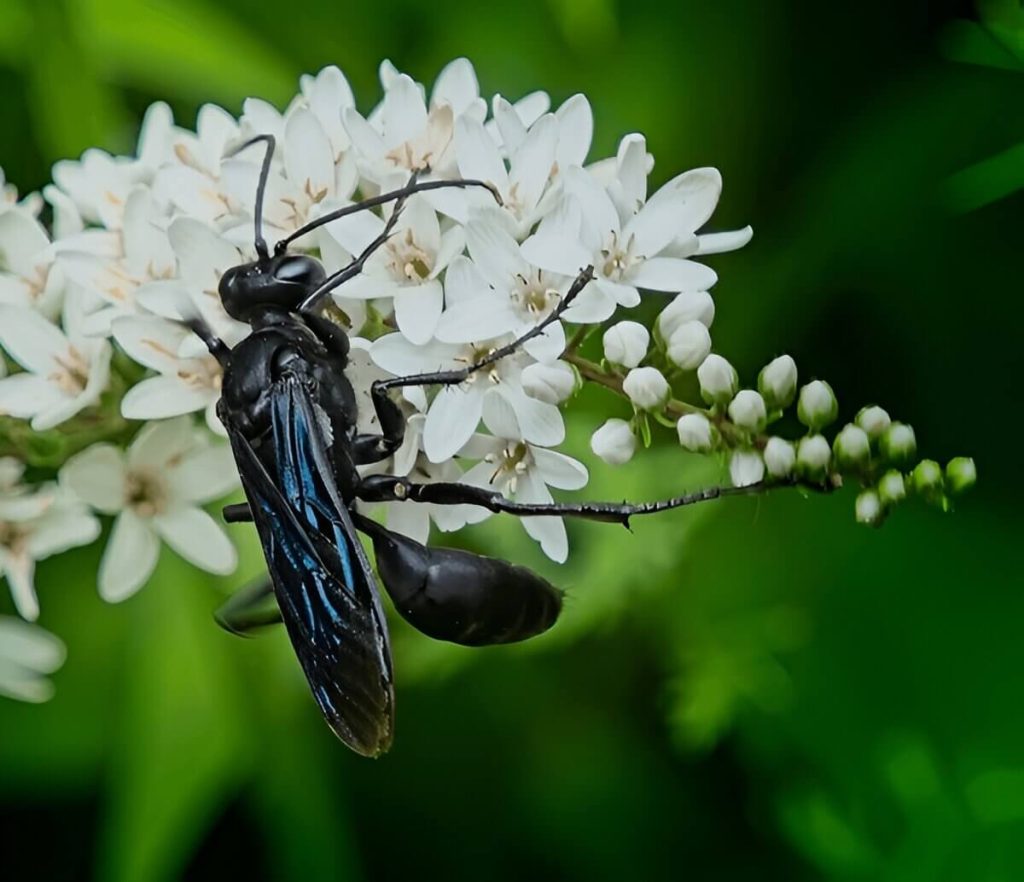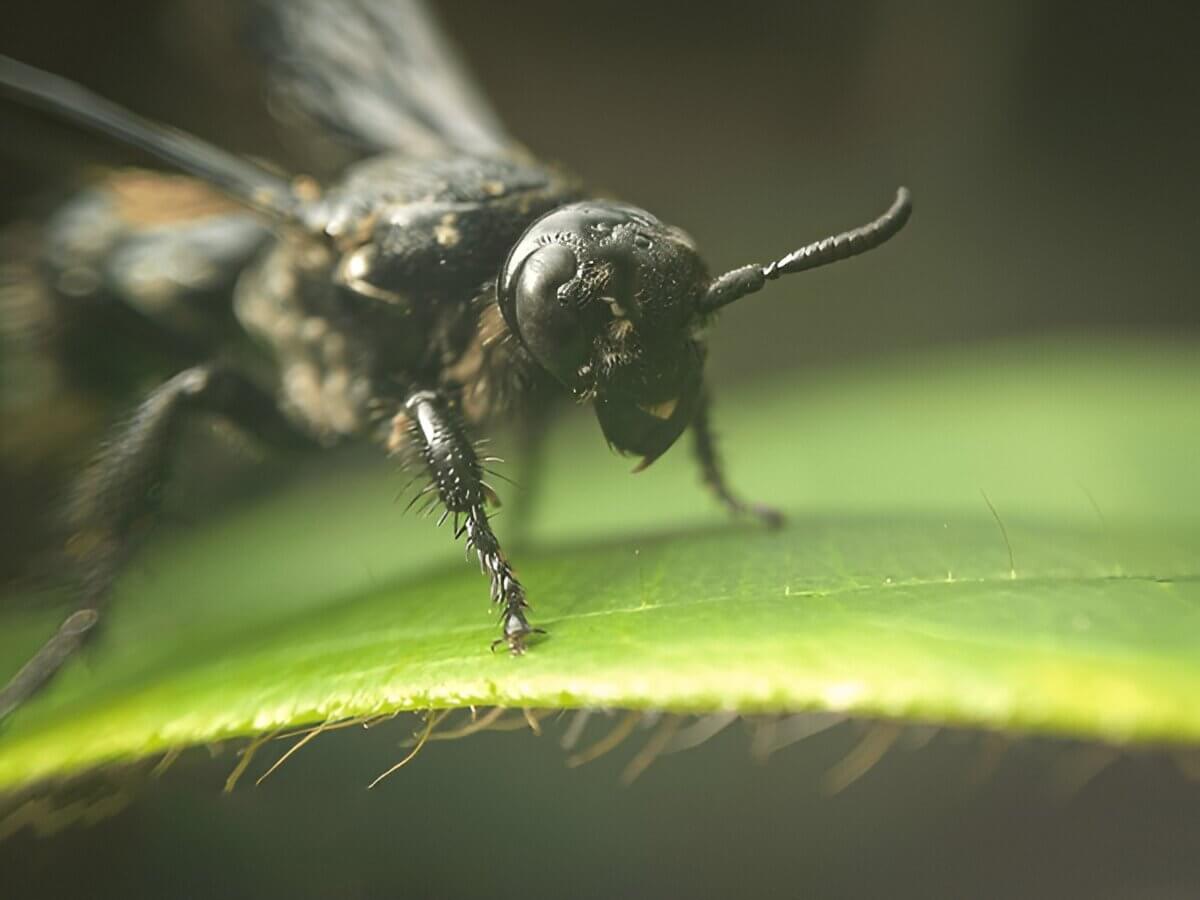Black wasps, often misunderstood and feared, are common in gardens. This guide helps identify black wasp species, understand their behaviors, and assess any risks they pose. It offers natural methods for managing them and advice on when to seek professional pest control. Explore this resource to coexist with or safely remove black wasps from your environment.
How to Identify Black Wasps
Identifying black wasps can be a straightforward task once you become familiar with their distinct characteristics. One of the most noticeable features of black wasps is their sleek, entirely black appearance. Unlike some other wasp species that display bright colors or patterns, black wasps maintain a uniform dark hue that makes them stand out.
When it comes to size, black wasps are generally larger than many of their colorful counterparts. They typically measure between 1 to 1.5 inches in length, making them quite prominent when observed up close. This substantial size is one of the key physical traits that aids in identifying black wasps.
Another characteristic feature is their elongated bodies and narrow waists, which are common among members of the wasp family. Their wings are also worth noting; they tend to be dark and may appear slightly iridescent under sunlight, adding a subtle sheen to their otherwise matte appearance.
In addition to these physical traits, observing behavior can also help in identifying black wasps. They are often solitary creatures and can frequently be seen hovering around flowers or gardens where they hunt for prey or search for nectar.
Are Black Wasps Dangerous? Assessing the Risks

When encountering a black wasp, it’s natural to question whether these insects pose any danger. Understanding their behavior and the potential risks is essential for assessing how to handle an encounter with them.
Firstly, it’s important to address the question: are black wasps aggressive? Generally, black wasps are not known for being aggressive. These solitary creatures tend to focus on their primary activities of hunting and nesting rather than seeking out conflict with humans. Unlike social wasps that defend their nests aggressively, black wasps typically avoid confrontation unless provoked or threatened.
However, do black wasps sting humans? While they have the capability to sting, it is relatively uncommon for them to do so without significant provocation. If a person inadvertently disturbs a nest or handles a wasp roughly, there is a possibility of being stung.
In the event of a sting, recognizing the symptoms of a black wasp sting can help in managing any discomfort or reactions effectively. Common symptoms include localized pain at the site of the sting, redness, and swelling. For most individuals, these symptoms are mild and resolve within hours or days. However, those who are allergic may experience more severe reactions and should seek medical attention promptly.
Understanding these aspects can alleviate unnecessary fear regarding black wasps while promoting safe interactions with these often misunderstood insects.
Sustainable Methods for Getting Rid of Black Wasps Naturally
When it comes to dealing with black wasps (often referred to as “black bloodsuckers”) many homeowners are seeking eco-friendly solutions that don’t rely on harsh chemicals. Fortunately, there are several sustainable methods available for natural pest control of these persistent insects.
One effective approach is the use of homemade repellents for black wasps. A simple mixture of water, white vinegar, and a few drops of essential oils such as peppermint or eucalyptus can act as a natural deterrent. Spraying this solution around areas where wasps are commonly seen can help keep them at bay without harming the environment.
Preventing black wasp nests without chemicals is another crucial step in managing these pests sustainably. Regularly inspecting your home and garden for early signs of nest building and removing potential nesting sites like old wood piles or dense shrubbery can discourage wasps from settling in. Additionally, sealing cracks and crevices around your home ensures that these insects have fewer opportunities to establish nests indoors.
By employing these natural methods, you can effectively manage black wasp populations while contributing to a healthier ecosystem.
Pest Control Solutions
When dealing with pests, knowing when to call in a professional exterminator can be crucial for maintaining a safe and comfortable environment. While some minor pest issues can be managed with DIY methods, certain situations require the expertise of professional pest control services.
One such scenario is the presence of black wasps or other stinging insects around your home or property. These insects not only pose a threat due to their painful stings but can also provoke allergic reactions in some individuals. Best practices in dealing with these stinging insects involve not attempting removal on your own, especially if you notice an increase in their numbers or if they have built nests close to human activity areas. Professional exterminators are equipped with the tools and knowledge needed to safely remove these pests without causing harm to you or themselves.
Another critical situation is when facing bloodsucker infestations, such as bed bugs or fleas. These pests are notoriously difficult to eradicate completely without specialized treatment plans. Professional pest control for bloodsuckers involves thorough inspection and tailored extermination services that ensure every stage of the insect’s lifecycle is addressed. This comprehensive approach helps prevent re-infestation and provides peace of mind that your home is free from these persistent invaders.
While it might be tempting to handle pest issues independently, recognizing when professional intervention is necessary can save time, money, and stress in the long run. Whether it’s dealing with black wasps or managing a bloodsucker infestation, relying on expert extermination services ensures effective and safe solutions tailored to your specific needs.
Maintaining a Black Wasp-Free Environment Safely and Effectively
In conclusion, maintaining a black wasp-free environment requires a balanced approach that prioritizes both safety and effectiveness. To start, regular inspection of your property is crucial. Look for potential nesting sites such as eaves, attics, and garden sheds. Removing these nests early can prevent larger infestations.
Natural deterrents are an excellent first line of defense. Planting mint or using essential oils like peppermint around your home can help repel black wasps without harming them or the environment. Additionally, ensuring that garbage bins are sealed tightly and food waste is managed properly will reduce attractants.
For more persistent issues, consider professional pest control services that use environmentally friendly methods to address the problem without posing risks to pets or beneficial insects. Remember, black wasps play a role in pollination and pest control; thus, completely eradicating them isn’t necessary or advisable.
By combining vigilance with eco-friendly solutions, you can maintain a harmonious balance between enjoying your outdoor spaces and coexisting safely with nature’s creatures.
